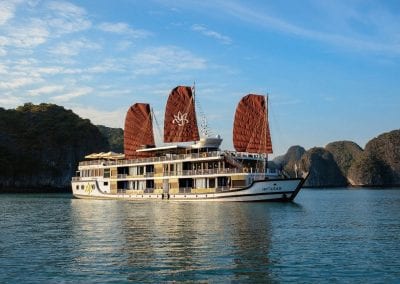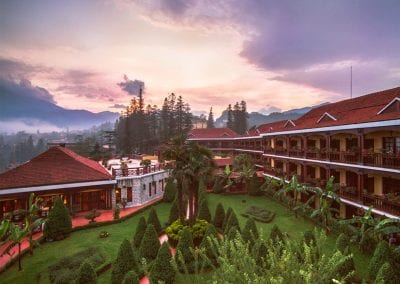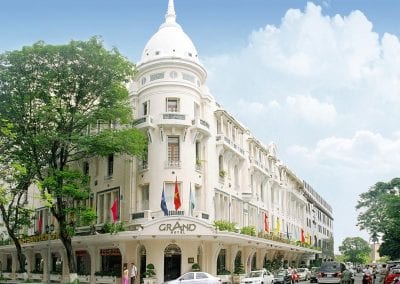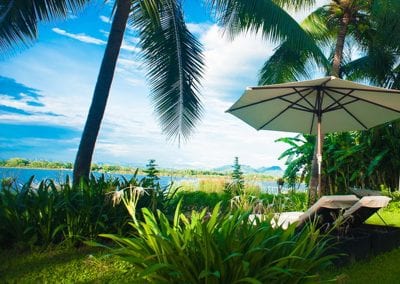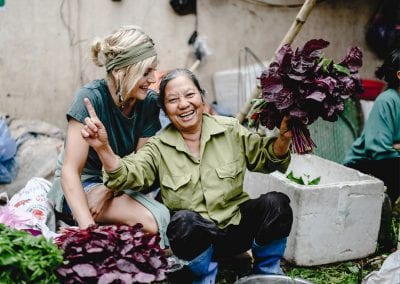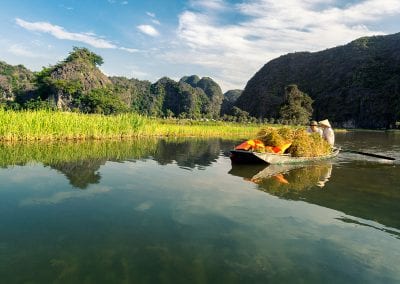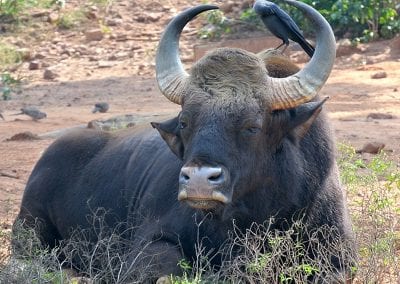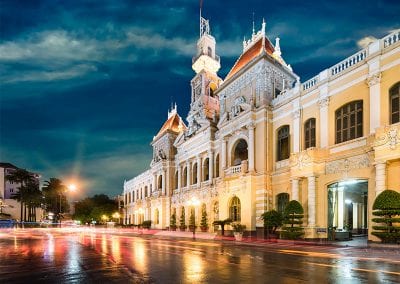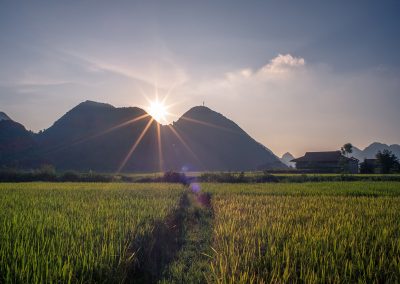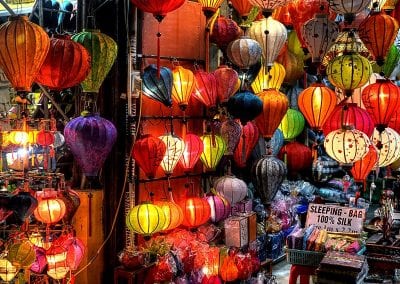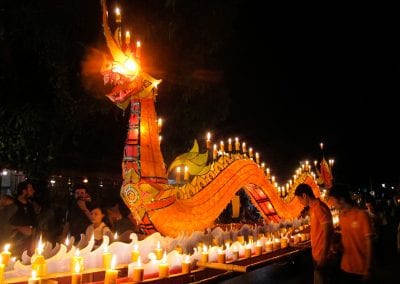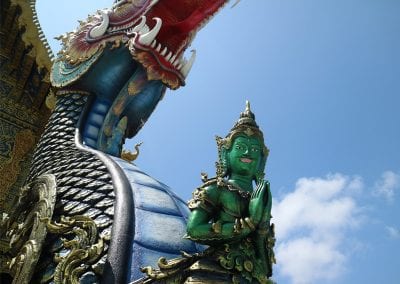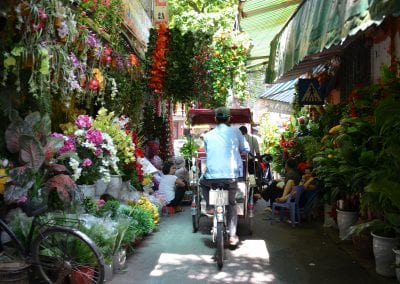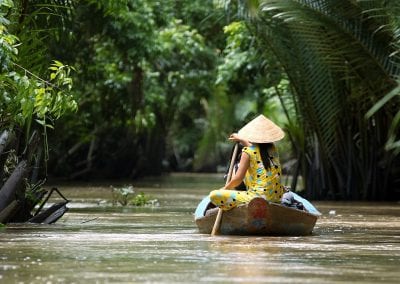JANUARY
In Hanoi and the north of Vietnam, January is one of the drier months. Blue skies and sunshine can be expected, but it remains quite cool, at around 18°C. You may encounter a misty haze, particularly in coastal areas and around
Ha Long Bay. In the far north it is advisable to have some warm clothing, as conditions can get quite chilly.
In Central Vietnam the weather improves as the rainy season comes to an end, with temperatures averaging around 23°C. The beaches at Hoi An and Nha Trang come back to life. In the Central Highlands, and Dalat, you can expect dry conditions, but a cooler temperature, especially at night.
Weather conditions are good in the south, with little rain expected. The beaches near Ho Chi Minh City have plenty of sunshine, as do the islands to the south – Phu Quoc and Con Dao. Temperatures average around 26°C.
FEBRUARY
Temperatures in North Vietnam are relatively cool in February (around 17°C), though skies will be clear and there is no shortage of sunshine. Rainfall is low, but a hazy mist may be encountered around Ha Long Bay and other coastal regions.
In Central Vietnam, temperatures are higher (around 25°C), with just an occasional light rain to be expected. The beaches of Hoi An and Nha Trang receive plenty of sunshine. The ancient royal capital Hue is dry and warm. Dalat, in the Central Highlands, is a little cooler because of the higher altitude, with excellent trekking and adventure activity conditions. It’s advisable to take a pullover for the evenings.
Further south, good weather can be expected throughout February. Temperatures average around 28°C, and there is little rain and plenty of sun on the beaches and islands of Phu Quoc and Con Dao. There are excellent diving conditions around Con Dao – the water is clear and visibility is good.
MARCH
North Vietnam enjoys plenty of sun and cloudless skies in March, and temperatures, although beginning to rise, remain cool at around 19°C. The mountains are less cool than in previous months, and trekking conditions are excellent in Sapa and Ha Giang.
In Central Vietnam, the beaches of Hoi An, Danang and Nha Trang are in full swing, with more or less constant sunshine and temperatures around 28°C. Hue and Dalat and the Central Highlands are warm and dry.
To the south, in the Mekong Delta and Ho Chi Minh City (Saigon), although the peak is not yet reached, temperatures are starting to rise. The beaches to the south, including Ho Tram and Long Hai, and the islands of Phu Quoc and Con Dao, are in full summer mode, with temperatures around 29°C. The island of Con Dao has excellent diving conditions.
APRIL
In April we are coming to the end of Vietnam’s high season, as far as weather is concerned. The north is approaching its hot, rainy summer, but there are still plenty of dry days. The beaches in the centre of Vietnam are still at their peak. The south becomes very hot, and rain starts to become more likely.
The mountains to the far north have excellent walking conditions, perfect for exploring regions such as Sapa and Mu Cang Chai. Temperatures average around 24°C. There will be a few wet days towards the end of the month.
The whole of Central Vietnam, from the beaches on the east coast (Hoi An, Nha Trang), to the ancient capital of Hue further north, to the Central Highlands and Dalat to the west, basks in sunshine and cloudless skies, with temperatures averaging around 28°C.
To the south, around the Mekong Delta, it certainly is getting hot, with temperatures around 31°C. The southern beaches (including Phan Thiet and Mui Ne) and the island of Phu Quoc are very popular destinations at this time of year.
MAY
May sees a rise in temperature in North Vietnam, with some chance of rain, although most days remain dry. Temperatures hover around 29°C. Conditions in the mountains are good – this is a good time to explore the Sapa region and Mu Cang Chai.
The beaches of Central Vietnam are at their peak – you can enjoy temperatures around 30°C in Nha Trang and Hoi An, with clear skies and no shortage of sunshine. To the north, Hue also has excellent weather. In Dalat and the Central Highlands to the west, rainfall is likely to be encountered, but it’s far from its height, and there is still a lot of dry weather to be enjoyed.
In the south, there is now more chance of rain. The advantage is that this brings some respite from the high temperatures of the previous months. You can expect an average of around 28°C. The downpours tend to occur in the afternoon and are usually short and sharp. Diving conditions around Con Dao Island remain good in May.
JUNE
Moving into June, North Vietnam is by now well into its summer, which means high temperatures (around 30°C), rain, and the occasional storm. The mountains in the far north see a lot of rain, so trekking is best avoided at this time of year.
Central Vietnam continues to enjoy cloudless skies and sunshine. This is the best time for the beaches of Danang, Hoi An and Nha Trang, with temperatures around 30°C. Hue also has good weather. Further west, Dalat and the Central Highlands see increasing rainfall, though it’s still possible to travel in the region.
The wet season is now firmly entrenched in the south. Showers may be slightly heavier than in previous months, but still not too severe, and there are still plenty of dry, sunny hours during the day. Temperatures average around 28°C. On the beaches of Con Dao, the Green Turtle nesting season begins in June.
JULY
In July, summer continues in the north of Vietnam, so you should expect hot conditions, plenty of rain, and the occasional thunderstorm. Temperatures hover around 30°C. Heavy showers can be expected in Ha Long Bay and Hanoi. Actually, July is one of the wettest months in Hanoi. The mountains in the far north are extremely wet, so trekking is not on the cards this month.
The beaches of central Vietnam continue to enjoy clear skies and sunny days, so Hoi An, Nha Trang and Danang are still popular destinations. Temperatures are high, at around 31°C, but the occasional rainfall offers relief from the heat. Hue has similar conditions. Due to rainfall, trekking is not advisable in Dalat and the Central Highlands to the west.
The monsoon season is now firmly entrenched in the south. But you can still expect plenty of dry, sunny spells during the day. Expect temperatures around 29°C. If you’re into diving, July is realistically the last month of the season around Con Dao Island.
AUGUST
August is not much different from July in the north of Vietnam. Temperatures remain high, around 30°C, rain and the occasional storm are to be expected. Heavy rainfall should be expected in Hanoi and Ha Long Bay. Due to heavy downpours, August is not a good month for trekking in the northern mountains.
In Central Vietnam, good weather can still be expected on the beaches of Nha Trang and Hoi An. Temperatures remain high, around 30°C, and, although still mainly dry, the rain will increase towards the end of the month. Nha Trang sees probably the best weather this month, though it may well become overcast by the end of the month. Hue experiences higher rainfall, and adventure activities are not advisable in the Central Highlands to the west.
More rainfall is to be expected in the south, around the Mekong Delta and Ho Chi Minh City, and the island of Phu Quoc. However, there should be plenty of dry sunny spells during the day, with temperatures averaging around 29°C. From the middle of August, newly-hatched Green Turtles can be seen on the beaches of Con Dao, edging towards the sea.
SEPTEMBER
In September, North Vietnam is approaching the end of the summer season, with plenty of sunshine still, and some rainfall. Temperatures average around 28°C. As the month draws to a close, temperatures drop a little, and there is less rainfall. In Sapa, in the far north, trekking becomes possible once again. The rice fields in Mu Cang Chai turn a beautiful golden colour, ready for harvesting.
In Hoi An and Hue, in Central Vietnam, rainfall increases throughout September. There may be some storms near the end of the month. Temperatures average around 28°C. In Nha Trang, the beaches experience more rainfall. The Central Highlands and Dalat can see heavy rain at this time of year, so trekking is not a good idea. Some of the caves in Phong Nha may be inaccessible due to flooding.
During the course of September, in the south, the Mekong Delta, Ho Chi Minh and Phu Quoc remain wet, but rainfall decreases. With average temperatures around 28°C it remains hot. Rain is still quite frequent, but there is plenty of dry, sunny weather as well.
OCTOBER
October heralds the end of the rainy season in North Vietnam, with less rainfall and lower temperatures (around 26°C) as the month progresses. Sapa and Ha Giang in the far north are clear and dry, with excellent trekking conditions.
In Central Vietnam the rainy season is at its peak – and there is a possibility of heavy storms. You may experience flooding in Hoi An this month. The beaches further south, including Nha Trang, see plenty of rain in October and November. In the Central Highlands and Dalat, the heavy rain begins to ease off, and by the end of the month conditions for trekking are good. However, due to weeks of heavy rain, some of the Phong Nha caves may be inaccessible.
In South Vietnam, rainfall also eases off as the area moves closer to its hot, dry summer, with temperatures around 27°C. The islands of Con Dao and Phu Qoc and the southern beaches of Mui Ne and Phan Thiet see sunshine once again, as the winter season draws to a close.
NOVEMBER
North Vietnam in November enjoys some of the best weather conditions of the year. There is little rain, and temperatures are moderate, around 24°C. In the extreme north, Sapa and the mountainous regions, conditions are clear and dry, excellent for trekking. November is also a great month for a junk cruise in Ha Long Bay.
In Central Vietnam, rainfall is at its peak. Heavy storms can be expected. There may be flooding in Hoi An. Further south, Nha Trang also sees plenty of rain. In Dalat and the Central Highlands skies are clear, with little rain.
In the south, November sees summer in full swing, with some of the best conditions of the year. Skies are clear, and humidity is low. Temperatures average around 27°C. The beaches close to Ho Chi Minh – Mui Ne, Phan Thiet, Long Hai and Ho Tram experience plenty of sun and blue skies. Out on the islands of Con Dao and Phu Quoc, conditions are also ideal.
DECEMBER
Fine weather continues in North Vietnam in December, with reasonable temperatures (around 19°C) throughout the area, and little rain. In Hanoi this is one of the driest months of the year. Sapa in the far north also enjoys excellent weather, however, it can become chilly in the evening, so appropriate apparel is recommended.
In central areas, the weather begins to improve, with less rainfall, however, storms may still be encountered. You can expect more rain in Hue than in Hoi An. Throughout this part of Vietnam, temperatures are near their lowest in the year, averaging around 24°C. Further south, rainfall continues in Nha Trang, though it diminishes as the month progresses. Dalat enjoys clear, dry days, though it can be cold in the evenings.
The south enjoys ideal conditions with little to no rain and clear blue skies. The beaches near Ho Chi Minh City bask in sunshine. It’s also the perfect time to visit the islands of Con Dao and Phu Quoc. Hho Chi Minh itself is a little cooler, around 26°C, with low humidity.
 Passport & Visa Information
Passport & Visa Information
 Trustpilot
Trustpilot
 Tripadvisor
Tripadvisor

